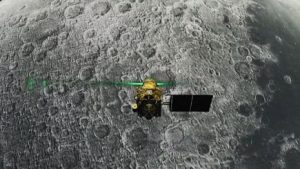Distribution Of Argon-40 On Moon:

Chandra’s Atmospheric Composition Explorer-2 (CHACE-2), a payload onboard Chandrayaan-2, has made the first-of-its-kind discovery on the distribution of one of the noble gases, Argon-40.
- India launched Chandrayaan-2, its second lunar exploration mission after Chandrayaan-1, from Satish Dhawan Space Centre, Sriharikota in July 2019.
- The gas found in the lunar exosphere is believed to have escaped from the lunar surface.
- The CHACE-2 observations reveal that the distribution in Ar-40 has significant spatial heterogeneity.
- There are localised enhancements (termed as Argon bulge) over several regions including the KREEP [potassium (K), Rare-Earth Elements, and Phosphorus (P)] on South Pole Aitken terrain (impact crater on the far side of the Moon).
- Noble gases serve as important tracers to understand the processes of surface-exosphere interaction, and Argon-40 (Ar-40) is such an important tracer atom to study the dynamics of the lunar exospheric species.
- It will also help decipher radiogenic activities in the first few tens of metres below the lunar surface.
- Ar-40 originates from the radioactive disintegration of Potassium-40 (K-40) present below the lunar surface.
- Once formed, it diffuses through the inter-granular space and makes its way up to the lunar exosphere through seepages and faults.




